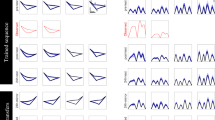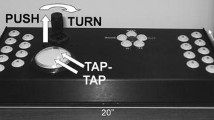Abstract
Considerable research has shown that both demonstration and verbal instruction can facilitate learning of a motor task in inexperienced individuals. In the current study, verbal instructions were used as a means to reduce the discovery learning process and control the amount of trial-to-trial variability in demonstrations. The task required models to learn to trace a pair of circles with a 90°-relative phase pattern between the arms. Verbal instructions directed one group of models toward a single strategy, and this group improved at a faster rate and performed better in a 24-h retention test compared to a group of models in a discovery learning context. The discovery models utilized multiple strategies throughout the practice. Each model was watched for 2 days by an observer, who was instructed that they would have to produce the 90°-relative phase pattern on day 3. Observers, who watched the discovery models, performed better than those who watched the single strategy models. The results support two primary conclusions. First, trial-to-trial variability associated with strategy selection processes in a model benefits an observer by facilitating perceptual discrimination processes that may play a key role in action generation. Second, verbal instructions that reduce discovery learning during physical practice benefit acquisition and retention performance when the task has multiple strategies wherein no one strategy guarantees the best performance outcome.



Similar content being viewed by others
Notes
The 90° offset is defined within the context of rhythmic oscillations of the limbs (finger, wrist, arms) that can range from a 0° to a ±180° offset. For a 0° offset, both limbs flex toward the body midline together and extend away from the body midline together. The 180° offset is defined as one limb reaching maximum flexion toward the body midline as the other limb reaches maximum extension away from the body midline. The 90° offset, then, has one limb reaching maximum flexion, while the other limb is halfway between maximum extension and maximum flexion.
References
Al-Abood, S. A., Davids, K., & Bennett, S. J. (2001). Specificity of task constraints and effects of visual demonstrations and verbal instructions in directing learners’ search during skill acquisition. Journal of Motor Behavior, 33(3), 295–305.
Bingham, G. P. (2004). A perceptually driven dynamical model of bimanual rhythmic movement (and phase perception). Ecological Psychology, 16(1), 45–53.
Bingham, G. P., Schmidt, R. C., & Zaal, F. T. J. M. (1999). Visual perception of the relative phasing of human limb movements. Perception and Psychophysics, 61(2), 246–258.
Buchanan, J. J., & Ryu, Y. U. (2005). The interaction of tactile information and movement amplitude in a multijoint bimanual circle-tracing task: phase transitions and loss of stability. Quarterly Journal of Experimental Psychology, 58A, 769–787.
Buchanan, J. J., & Ryu, Y. U. (2006). One-to-one and polyrhythmic temporal coordination in bimanual circle tracing. Journal of Motor Behavior, 38(3), 163–184.
Buchanan, J. J., Zilhman, K., Ryu, Y. U., & Wright, D. A. (2007). Learning and transfer of a relative phase pattern and a joint amplitude ratio in a rhythmic multijoint arm movement. Journal of Motor Behavior, 39, 49–67.
Buchanan, J. J., Ryu, Y. U., Zihlman, K., & Wright, D. A. (2008). Observational practice of a relative phase pattern but not an amplitude ratio in a multijoint task. Experimental Brain Research, 191, 157–169.
Burgess-Limerick, R. J., Abernethy, B., & Neal, R. J. (1991). Note: A statistical problem in testing invariance of movement using the phase plane model. Journal of Motor Behavior, 23, 301–303.
Carroll, W. R., & Bandura, A. (1985). Role of timing of visual monitoring and motor rehearsal in observational learning of action patterns. Journal of Motor Behavior, 17, 269–281.
Carroll, W. R., & Bandura, A. (1987). Translating cognition into action: The role of visual guidance in observational learning. Journal of Motor Behavior, 19, 385–398.
Carson, R. G., Thomas, J., Summers, J. J., Walters, M. R., & Semjen, A. (1997). The dynamics of bimanual circle drawing. The Quarterly Journal Of Experimental Psychology, 50A(3), 664–683.
de Poel, H. J., Peper, C. E., & Beek, P. J. (2008). Laterally focused attention modulates asymmetric coupling in rhythmic interlimb coordination. Psychological Research, 72, 123–137.
de Poel, H. J., Peper, C. E., & Beek, P. J. (2009). Disentangling the effects of attentional and amplitude asymmetries on relative phase dynamics. Journal of Experimental Psychology: Human Perception and Performance, 35(3), 762–777.
Fowler, C. A., & Turvey, M. T. (1978). Skill acquisition: an event approach with special reference to searching for the optimum of a function of several variables. In G. E. Stelmach (Ed.), Information processing in motor control and learning (pp. 2–40). New York: Academic.
Franz, E. A. (2004). Attentional distribution of task parameters to the two hands during bimanual performance of right- and left-handers. Journal of Motor Behavior, 36(1), 71–81.
Gibson, J. J., & Gibson, E. J. (1955). Perceptual learning: differentiation or enrichment. Psychological Review, 62(1), 32–41.
Hayes, S. J., Hodges, N. J., Huys, R., & Williams, A. M. (2007). End-point focus manipulations to determine what information is used during observational learning. Acta Psychologica, 126, 120–137.
Hodges, N. J., Chua, R., & Franks, I. M. (2003). The role of video in facilitating perception and action of a novel coordination movement. Journal of Motor Behavior, 35(2), 247–260.
Hodges, N. J., & Franks, I. M. (2000). Attention focusing instructions and coordination bias: implications for learning a novel bimanual task. Human Movement Science, 19, 843–867.
Hodges, N. J., & Franks, I. M. (2001). Learning a coordination skill: Interactive effects of instruction and feedback. Research Quarterly for Exercise and Sport, 72, 132–142.
Hodges, N. J., & Franks, I. M. (2002). Learning as a function of coordination bias: Building upon pre-practice behaviours. Human Movement Science, 21, 231–258.
Hodges, N. J., & Lee, T. D. (1999). The role of augmented information prior to learning a bimanual visual–motor coordination task: Do instructions of the movement pattern facilitate learning relative to discovery learning? British Journal of Psychology, 90, 389–403.
Hodges, N. J., Williams, A. M., Hayes, S. J., & Breslin, G. (2007). What is modelled during observational learning? Journal of Sports Sciences, 25(5), 531–545.
Johansson, G. (1973). Visual perception of biological motion and a model for its analysis. Perception and Psychophysics, 14, 201–211.
Lee, T. D., Swinnen, S. P., & Verschueren, S. (1995). Relative phase alterations during bimanual skill acquisition. Journal of Motor Behavior, 27(3), 263–274.
Mardia, K. V. (1972). Fundamentals of experimental design. Boston: Allyn and Bacon.
Martens, R., Burwitz, L., & Zuckerman, J. (1976). Modeling effects on motor performance. The Research Quarterly, 47(2), 277–291.
Mattar, A. A. G., & Gribble, P. L. (2005). Motor learning by observation. Neuron, 46, 153–160.
McCullagh, P., Weiss, M. R., & Ross, D. (1989). Modeling considerations in motor skill acquisition: An integrated approach. Exercise and Sports Sciences Reviews, 17, 475–513.
Peper, C. E., de Boer, B. J., de Poel, H. J., & Beek, P. J. (2008). Interlimb coupling strength scales with movement amplitude. Neuroscience Letters, 437, 10–14.
Pollock, B. M., & Lee, T. D. (1992). Effects of the model’s skill level on observational motor learning. Research Quarterly for Exercise and Sport, 63(1), 25–29.
Ryu, Y. U., & Buchanan, J. J. (2004). Amplitude scaling in a bimanual circle drawing task: Pattern switching and end-effector variability. Journal of Motor Behavior, 36, 265–275.
Scully, D. M., & Newell, K. M. (1985). Observational learning and the acquisition of motor skills: toward a visual perception perspective. Journal of Human Movement Studies, 11, 169–186.
Semjen, A., Summers, J. J., & Cattaert, D. (1995). Hand coordination in bimanual circle drawing. Journal of Experimental Psychology: Human Perception and Performance, 21(5), 1139–1157.
Vereijken, B., & Whiting, H. T. A. (1990). In defence of discovery learning. Canadian Journal of Sport Science, 15(2), 99–106.
Vogt, S., & Thomaschke, R. (2007). From visuo–motor interactions to imitation learning: Behavioural and brain imaging studies. Journal of Sports Sciences, 25(5), 497–517.
Weir, P. L., & Leavitt, J. L. (1990). The effects of model’s skill level and model’s knowledge of results on the acquisition of an aiming task. Human Movement Science, 9, 369–383.
Whiting, H. T. A., & Vereijken, B. (1993). The acquisition of coordination in skill learning. International Journal of Sport Psychology, 24, 343–357.
Wilson, A. D., Collins, D. R., & Bingham, G. P. (2005). Perceptual coupling in rhythmic movement coordination: Stable perception leads to stable action. Experimental Brain Research, 164, 517–528.
Wulf, G., & Prinz, W. (2001). Directing attention to movement effects enhances learning: A review. Psychonomic Bulletin and Review, 8, 648–660.
Wulf, G., & Weigelt, C. (1997). Instructions about physical principles in learning a complex motor skill: To tell or not to tell. Research Quarterly for Exercise and Sport, 68(4), 362–367.
Zaal, F. T. J. M., Bingham, G. P., & Schmidt, R. C. (2000). Visual perception of mean relative phase and phase variability. Journal of Experimental Psychology: Human Perception and Performance, 26(3), 1209–1220.
Zanone, P. G., & Kelso, J. A. S. (1997). Coordination dynamics of learning and transfer: Collective and component levels. Journal of Experimental Psychology: Human Perception and Performance, 23(5), 1454–1480.
Author information
Authors and Affiliations
Corresponding author
Rights and permissions
About this article
Cite this article
Buchanan, J.J., Dean, N.J. Specificity in practice benefits learning in novice models and variability in demonstration benefits observational practice. Psychological Research 74, 313–326 (2010). https://doi.org/10.1007/s00426-009-0254-y
Received:
Accepted:
Published:
Issue Date:
DOI: https://doi.org/10.1007/s00426-009-0254-y




